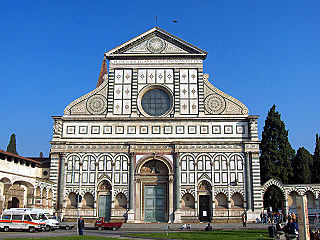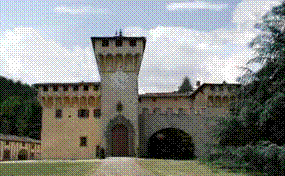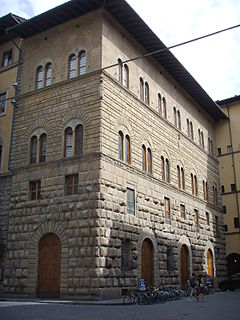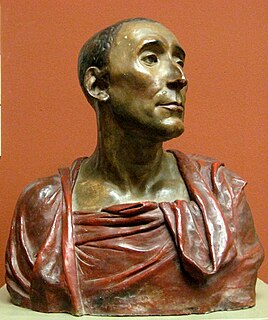Description
The palace was built perhaps by Lorenzo di Bicci (although other scholars have attributed it to Filippo Brunelleschi) for Niccolò da Uzzano. It was finished around 1426. After his death a few years later, it was acquired by the Capponi family
It has a 15th-century late-Gothic façade with a sober rustication at the lower floor, surmounted by irregular rows of mullioned windows (some closed and replaced by rectangular openings). The plan is nearly square, with a central courtyard in Renaissance style. This has porticoes on each side, with graffiti decorations dating to the 1450s and octagonal capitals in a still late medieval style. The porticoes are cross-vaulted.
The entrance on Via de' Bardi has fresco, attributed to Lorenzo di Bicci himself, with two flying figures holding the Uzzano coat of arms. Internally, at the feet of the main staircase, is a porphyry lion, an ancient Roman sculpture from the 2nd century AD. In the piano nobile is a small chapel with an altarpiece by Pontormo, perhaps taken from the Barbadori Chapel of the church of Santa Trinita. There is also a stained glass window, with the Deposition from the Cross, by Guillaume de Marcillat (1526).
The rear façade, added in the 19th century, overlooks the Arno River.

Renaissance architecture is the European architecture of the period between the early 14th and early 16th centuries in different regions, demonstrating a conscious revival and development of certain elements of ancient Greek and Roman thought and material culture. Stylistically, Renaissance architecture followed Gothic architecture and was succeeded by Baroque architecture. Developed first in Florence, with Filippo Brunelleschi as one of its innovators, the Renaissance style quickly spread to other Italian cities. The style was carried to Spain, France, Germany, England, Russia and other parts of Europe at different dates and with varying degrees of impact.

Santa Maria Novella is a church in Florence, Italy, situated opposite, and lending its name to, the city's main railway station. Chronologically, it is the first great basilica in Florence, and is the city's principal Dominican church.

Santa Felicità is a Roman Catholic church in Florence, region of Tuscany, Italy, probably the oldest in the city after San Lorenzo. In the 2nd century, Syrian Greek merchants settled in the area south of the Arno and are thought to have brought Christianity to the region. The first church on the site was probably built in the late 4th century or early 5th century and was dedicated to Saint Felicity of Rome. A new church was built in the 11th century and the current church largely dates from 1736–1739, under design by Ferdinando Ruggieri, who turned it into a one nave edifice. The monastery was suppressed under the Napoleonic occupation of 1808–1810.

The Palazzo della Cancelleria is a Renaissance palace in Rome, Italy, situated between the present Corso Vittorio Emanuele II and the Campo de' Fiori, in the rione of Parione. It was built 1489–1513 by Baccio Pontelli and Antonio da Sangallo the Elder as a palace for Cardinal Raffaele Riario, Camerlengo of the Holy Roman Church, and is regarded as the earliest Renaissance palace in Rome. The Palazzo houses the Papal Chancellery, is an extraterritorial property of the Holy See, and is designated as a World Heritage Site.

Poggibonsi is a town in the province of Siena, Tuscany, central Italy. It is located on the river Elsa and is the main centre of the Valdelsa Valley.

Uzzano is a comune (municipality) in the Province of Pistoia in the Italian region Tuscany, located about 45 kilometres west of Florence and about 15 kilometres (9 mi) southwest of Pistoia.

The Villa Medicea di Cafaggiolo is a villa situated near the Tuscan town of Barberino di Mugello in the valley of the River Sieve, some 25 kilometres north of Florence, central Italy. It was one of the oldest and most favoured of the Medici family estates, having been in the possession of the family since the 14th century, when it was owned by Averardo de' Medici. Averardo's son, Giovanni di Bicci de' Medici, is considered to be the founder of the Medici dynasty.

Gothic architecture appeared in the prosperous independent city-states of Italy in the 12th century, later than in Northern Europe. Each city developed its own particular variations of the style. Italian architects preferred to keep the traditional construction methods established in the previous centuries; architectural solutions and technical innovations of French Gothic were seldom used. Soaring height was less important than in Northern Europe. Brick rather than stone was the most common building material, and marble was widely used for decoration. In the 15th century, when the Gothic style dominated northern Europe and Italy, the north of the Italian Peninsula became the birthplace of Renaissance architecture.

Lorenzo di Bicci was an Italian painter of the Florentine School considered to be one of the most important painters in Florence during the second half of the 14th century. He is believed to have learned his trade from his father, about whom little is known. Lorenzo’s style, as well as that of his contemporaries Jacopo di Cione and Niccolò di Pietro Gerini, was influenced by the artist Andrea di Cione. Lorenzo's paintings made use of bright colors and his compositions avoided complexity. The figures he painted tended to have round faces and were often expressionless. Another one of Lorenzo's distinctive characteristics was his precision of execution. He was known for exceptional talent in drawing, an ability that he put to use at the initial stages of his painting. Unlike many celebrated Florentine artists of this period, Lorenzo mostly received commissions from the country clergy and from the lower-middle class Florentine guilds. His successors, Bicci di Lorenzo and Neri di Bicci, continued to serve these groups.

The Virgin and Child with the Infant Saint John the Baptist is a tempera painting on wood executed by the Italian Renaissance master Sandro Botticelli and his studio. The tondo, painted in Florence between the years of 1490 and 1500, addresses a central theme of the Italian Renaissance art: the divine motherhood. The work is now in the São Paulo Museum of Art.

The Barbadori Chapel, later Capponi Chapel, is a chapel in the church of Santa Felicita in Florence, central Italy. It was designed by Filippo Brunelleschi, and was later decorated by a cycle of works by the Mannerist painter Pontormo.

The Basilica of San Giacomo Maggiore is an historic Roman Catholic church in Bologna, region of Emilia Romagna, Italy, serving a monastery of Augustinian friars. It was built starting in 1267 and houses, among the rest, the Bentivoglio Chapel, featuring numerous Renaissance artworks.

Palazzo Antinori is a Renaissance palace located at the north end of Via de' Tornabuoni, where it makes an odd corner with Via dei Pecori, Via del Trebbio, and converts into Via dei Rondinelli, in Florence, region of Tuscany, Italy.

Palazzo dello Strozzino is a Renaissance palace in Florence, region of Tuscany, Italy. The stone Renaissance facade is located on Piazza degli Strozzi, diagonal to the Southeast corner of the imposing Palazzo Strozzi. The Northern façade on Via dei Anselmi houses the entrance to the Cinema Odeon.

Niccolò da Uzzano was an Italian politician, the Gonfaloniere of Justice in the government of Florence

Palazzo degli Alberti is a historical building in the center of Prato, Tuscany, central Italy. It was the seat of Cassa di Risparmio di Prato and was home to the former's large art collection. In 2013 it was reported that Banca Popolare di Vicenza moved all the collection to Vicenza after liquidated Cariprato.

The Palazzo Spannocchi is a Renaissance style urban palace located on the Piazza Salimbeni, just off Via Banchi di Sopra in the Terzo di Camollia of the city of Siena, region of Tuscany, Italy. The building was associated with an ancient mercantile family of Siena.

The Palazzo Nasi, also known as the Palazzo Torrigiani or Palazzo Scarlatti, is a palace located at Piazza de' Mozzi 4, down the street where the Ponte alle Grazie enters the Oltrarno, in Florence, Tuscany, Italy. Another Palazzo Torrigiani Del Nero, with a Mannerist or late-Renaissance-style facade stands closer to the river. Both palaces also once belonged to the Nasi. The palace is a few steps from the Palazzo Mozzi.
The Palazzo Tempi, also known as Palazzo Vettori or Bargagli Petrucci, is a palace located along the Arno river at the narrow Piazza Santa Maria Soprarno 1, corner with Via de' Bardi and Costa dei Magnoli in the Oltrarno section of Florence, Tuscany, Italy. The palace is across the river from the Galleria of the Uffizi, and a block east of the Ponte Vecchio. The Via de' Bardi originates in an arch under the building.

Santa Lucia or Santa Lucia dè Magnoli is a Roman Catholic church located on via de'Bardi in Oltrarno district of Florence, region of Tuscany, Italy.



















